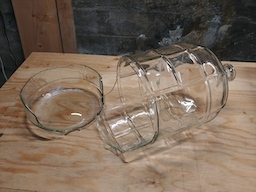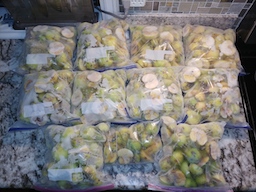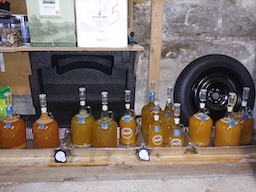Introduction
My house has a large apple tree. For the first two years, I would slice and freeze multiple gallon bags of apples, premix the dry ingredients for apple crumbles and crisps, and spend the ensuing year tossing the parts together to make quick on-the-fly crumbles and crisps. Other things I did with the apples included various baking (apple bread, etc.) and mulled cider, which consists of submerging halfed or quartered apples in water in a crockpot with various spices. But I couldn't keep up with the tree and would lose large quantities to the ground every year. In the third year, 2020, I decided to try making hard cider, which is the American term for fermented alcoholic cider. I had never attempted to make wine, mead, or beer before. I don't drink beer at all so I have no motivation to make beer and I was under the impression that making good wine was so difficult as to be a waste of time. But I had all these apples anyway and a little research suggested that cider was considerably easy to get "pretty good" than wine. Additionally, as of 2020 I was now in possession of a 20-ton hydraulic press for the first time (I had purchaseed it with the intent to make handpans, a project that fizzled almost immediately, leaving me with a large expensive workshop tool that sat unused for most of 2020), so I now had the means to press cider instead of mulling it in a crockpot. Hence an idea was born.
Apple Varieties
It took me three seasons to figure out that I'm quite certain my apple tree is a two-variety graft. I had discoverd early on that it appears to produce two types of apples, but I always assumed the green, tart apples that fell much later were simply failed apples that had not ripend and generally didn't drop until the season was simply and utterly done with them. I knew the two varieties tended to occur on different parts of the tree, two main forks off the base trunk, but again I rationalized it in my mind that the green, tart, late apples all came from one sub-trunk because the entire sub-trunk was miserly. Such was my thinking. But I now believe the tree produces two completely different varieties and that I have been wasting the later apples by refusing to use them the first two years I had the house. So be it.
Also note that for the third cider batch made in 2020, described below, I used apples from a friend's tree, so obviously there is no expected similarity or comparison to be made there relative to the other batches; batch 3 is made from an unrelated batch of apples. Batch 1 is from the slightly redder, sweeter, earlier-ripening variety on my tree, while batches 2 and 4 are from the green, tart, later variety on my tree.
Apple Cider vs. Apple Wine
One minor note worth understanding is the distinction between apple cider and apple wine. It turns out that the distinction is both sutble and vague. It mostly comes down to how much alcohol the product contains, which in turns originates with how much sugar is in the initial pressed cider prior to fermentation. One good rule of thumb is that if you ferment cider using only its natural sugar content, then you are making cider, whereas if you add sugar to the cider after pressing and before fermentation, then you are making wine. However, since the natural sugar content (and corresponding potential fermented alcohol) of pressed cider can vary widely with apple variety, time of picking, and perhaps other factors, it is a rather blurred distinction. An unsweetened cider could very well result in the same final alcohol level as a sweetened cider, depending on their initial sugar levels and the amount of sugar added. That said, I have added sugar to all my pressed cider prior to fermenting it, so by that reasoning, I make apple wine, not cider. However, since some of my cider ended up with a fairly low sugar content even after I explicitly added sugar, and since the consequent alcohol level is not necessarily all that high, it remains a vague distinction whether all my batches should be branded wine as opposed to cider.
Apple Pressing
Traditionally, apple cider would be made by grinding or mashing apples and then putting them in a wooden screw press. However, I had a 20-ton hydraulic press available already, so I use that, in conjunction with a 5-gallon bucket drilled full of holes, instead. I also had to make a trough for the bucket to sit on, which consists of deep channels to efficiently drain the juice out from under the press bucket into a collection bucket.
2020 Batches
In 2020 I made four batches. I won't include the full brew log below, but here are the basic facts:
2020 batch 1
- Variety: this is how I finished off the slightly redder, sweeter, earlier-ripening apples, the only apples I ever used for anything the first two years I had the house.
- Pressed yield: 2 gallons.
- Yeast: Safale S-04.
- Initial specific gravity and corresponding potential alcohol if fully fermented:
- Other notes: Pasteurized after pressing. 50/50 white/brown sugar added during cool-down. Being my first batch ever, I didn't know fast from slow fermentation, but after batch 2, I concluded that this batch was the livelier of the two in terms of initial airlock bubbling rate and and "tiny bubble fizz" activity within the brew. However, batch 3 blew it away, as described below.
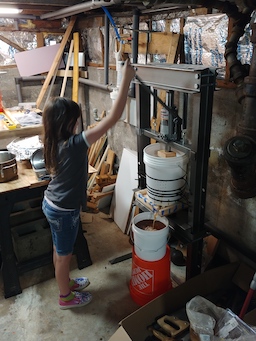

_256px.jpg)
2020 batch 2
- Variety: the green, tart, later-ripening apples.
- Pressed yield: 2 gallons.
- Yeast: Lallemand Nottingham Ale.
- Initial specific gravity and corresponding potential alcohol if fully fermented:
- Other notes: Pasteurized after pressing. 50/50 white/brown sugar added during cool-down. This batch fermented very slowly and never really picked up speed.
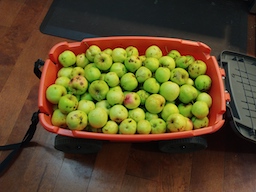
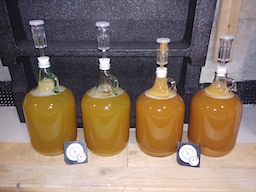
2020 batch 3
- Variety: my friend's apples, something green and of intermediate sweetness.
- Pressed yield: 5.5 gallons, but the 3-gallon carboy shattered, as described below, for a final yield of 3 gallons.
- Yeast: Initially Red Star Cote des Blancs. I got no initial fermentation and added Cider House Select a few days later, which fermented very aggressively compared to batches 1 and 2.
- Initial specific gravity and corresponding potential alcohol if fully fermented:
- Other notes: Pasteurized after pressing. 50/50 white/brown sugar and yeast nutrient added during cool-down. Cambden tablets and pectic enzyme added after pasteurization but before fermentation.
I hadn't intended to make any more cider in 2020 after the second batch, but my friend invited me over to pick apples, and thus batch 3 came to pass. This pressing yielded a whopping 5.5 gallons, which I distributed into my first 3-gallon carboy (I had use two 1-gallon jugs for each of batches 1 and 2) plus three 1-gallon jugs, the last of which only filled half way, but I expected primary fermentation to suffer little oxidation as the headspace should fill with CO2 gas anyway. After a few days, there still wasn't any fermentation whatsoever. I attempted to stir the jugs to reintroduce initial oxygen into the brew to help the yeast get started, and in the process shattered the 3-gallon carboy. 2.5 gallons of cider spilled unchecked across my basement floor while half a gallon was recovered from the deep basting trays I had placed the carboy and jugs in. That was a very bad night, a roller coaster of emotions. I distributed the salvaged half gallon to the remaining three 1-gallon jugs (mostly the half-empty jug previously mentioned) and soon thereafter pitched a different kind of yeast than I had initially attempted with this batch, this time trying Cider House Select yeast. The result was rather spectacular. This batch took off at an incredible rate, with the airlocks of all three jugs bubbling every few seconds, and with a similar vigorousness observed in the tiny CO2 bubbles fizzing within the brew. Compare this rate to both batches 1 and 2, which had hummed along at a reliable but much lazier rate of two or three bubbles per minute (quite a bit slower as the weeks dragged on). So, batch 3 has both been a disappointment in terms of failed initial fermentation and the heartbreak of destroying a carboy and losing half the cider, and also a remarkable surprise in the energetic fermentation it eventually produced.
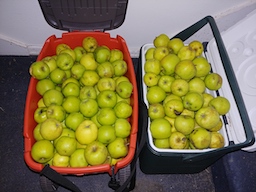
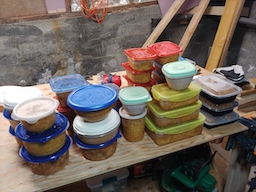
_256px.jpg)
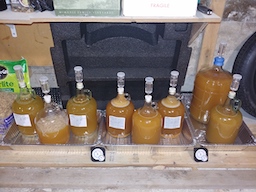
2020 batch 4
- Variety: the green, tart, later-ripening apples.
- Pressed yield: 3.5 gallons
- Yeast: Red Star Cotes des Blancs
- Initial specific gravity and corresponding potential alcohol if fully fermented:
- Other notes: Pasteurized after pressing. 50/50 white/brown sugar added. Yeast nutrient added. Cambden tablets added before fermentation.
As noted above, I didn't intend to make any batches after batch 2 in 2020. After I started batch 3, I once again intended to make no more cider that year. But after the calamity of destroying a 3-gallon carboy and sending a 2.5 gallon deluge of wasted cider across my basement floor, I was in such a fowl spirit that I stomped out to my tree and cleaned it right off of its remaining apples for the year. I would have surely otherwise left them to fall, I am certain of it, but I had to rebalance the universe, and that required making one more batch for the year. In the end, batch 4 produced more cider (3.5 gallons) that I lost in the spill from batch 3 (2.5 gallons lost).
